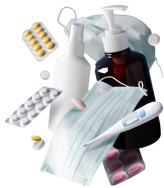Healthwire Pharmacy provides 100% genuine medicines straight to your doorstep.
Order Now! & Avail
Upto 10% OFF On All Your Pharmacy Orders!
Glimepiride 2mg, Pioglitazone 15mg
Healthwire Pharmacy Ratings & Reviews (1500+)
Product Information
Diabetes mellitus type 2 can be challenging to deal with, but certain drugs can help manage the symptoms. Pioglitazone 15mg and Glimepiride 2mg are two medications that can be used in combination to treat this condition. Pioglitazone increases the body's sensitivity to insulin and reduces sugar production in the liver, helping to regulate blood sugar levels. Glimepiride, on the other hand, stimulates the release of insulin from the pancreas, raising natural insulin levels and bringing down blood sugar. Taken together, Pioglitazone and Glimepiride can make a powerful team in combatting the symptoms of type 2 diabetes. It's important to note, however, that any drug treatment should be under the supervision of a qualified medical professional and be part of a wider approach to health that includes healthy eating and exercise.
Glimepiride 2mg, Pioglitazone 15mg
Thiazolidinedione
Tablet
Glimepiride, Pioglitazone combination is utilized for the following therapeutic indications:
Tailoring Treatment for Optimal Health, Prescribed Medication Dosage is:
An overdose of Pioglitazone 15mg and Glimepiride 2mg can be life-threatening. If you recognize these symptoms in another, it's important to contact emergency services immediately. The patient will require immediate medical attention as an overdose can lead to severe complications.
If you missed a dose of your medication, it is important to seek advice from your healthcare provider to determine the best course of action. Depending on the timeframe of your next dose, it is typically recommended to take the missed dose as soon as possible unless it is shortly before your next scheduled dose. In this case, it is usually safer to skip the missed dose and return to your regular dosing schedule. It is important to note that doubling up on doses or taking additional medication to make up for a missed dose can lead to an overdose or undesirable symptoms. To ensure the safety and effectiveness of your medication, it is always advisable to consult with your doctor, pharmacist, or healthcare provider before taking any medication, including over-the-counter drugs while you are taking pioglitazone and glimepiride. They can provide guidance specific to your condition and advise you on how to manage missed doses or any other concerns you may have.
Before starting your medication regimen for Pioglitazone 15mg and Glimepiride 2mg, it's important to read the information provided with your medication packets. If you have any questions, be sure to ask your healthcare provider or pharmacist for clarification. For Pioglitazone 15mg, it is typically recommended that you take the tablet once daily, preferably with dinner. Consistency is key, so take it at the same time each day to keep your blood levels stable. It's also important to swallow the tablet whole, avoiding crushing or chewing, and wash it down with a glass of water. Starting with a low dose and gradually increasing it over time is normal, so follow your doctor's instructions and don't stop taking the medication without their advice. Glimepiride 2mg is typically taken once or twice daily, preferably with breakfast and dinner. Again, consistency is important for maintaining stable blood levels. This medication should also be swallowed whole with a glass of water and not chewed or crushed. Your doctor may start you on a low dose and gradually increase it to effectively manage your blood sugar levels. If you are also taking a sulfonylurea to manage your diabetes, your doctor may advise you to stop taking it to avoid low blood sugar episodes. Overall, it is important to monitor your blood regularly to ensure that your blood sugar levels are balanced. Remember to always consult your doctor or healthcare provider if you have any questions or concerns about your medication.
Discerning instances where this medication may not be appropriate:
Unraveling the side effects lurking behind this medications are as follows:
Store Pioglitazone in a cool, dry place preferably at room temperature, which is between 68°F to 77°F (20°C to 25°C). Avoid placing it in direct sunlight or near sources of heat or moisture, as this can hamper the medication's effectiveness. Keep Pioglitazone out of reach for children, as it is intended for adult use only and may be harmful to children or pets. Freezing Pioglitazone is not recommended as extreme cold temperatures can alter the composition of the medication, rendering it ineffective. It is also important to track the expiration date of your Pioglitazone medication, as it does have an expiration date and should be replaced after two to three years of use. You can find the expiration date listed on the label or packaging. If you have any questions or concerns about storing your medication, reach out to your pharmacist for guidance. Following these storage instructions ensures that your Pioglitazone medication remains effective and safe for use. Please let me know if you'd like me to clarify or expand on any of the provided storage tips.
When taking medications like Pioglitazone and Glimepiride, it is crucial to monitor various aspects of your health to ensure the drugs are effective and complications are prevented. Lab tests are an important aspect of this monitoring process. Here are some tests you should undergo periodically, as advised by your healthcare provider:

Order Now! & Avail
Upto 10% OFF On All Your Pharmacy Orders!

If you face any issue, feel free to contact us. We provide 24/7 support to assist your problems